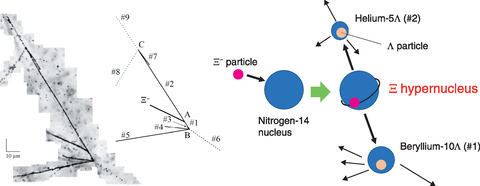
Fig.3-4 Picture (left) and schematic drawing (right) of the new Ξ hypernucleus event
Although normal nuclei comprise protons and neutrons, special nuclei called hypernuclei containing baryons with strange quarks are known to exist; two such hypernuclei are Lambda (Λ) and Xi (Ξ) baryons. Λ hypernuclei, which contain one strange quark, have been extensively studied, whereas hypernuclei with a Ξ particle, which contains two strange quarks, have been rarely studied.
There are several motivations to study Ξ hypernuclei, one of which is neutron stars. Ξ is one of the particles that could appear in neutron stars, and whether or not it appears depends on the interaction with protons and neutrons. Therefore, it is important to determine the strength of the interaction using ground experiments; high-quality experimental data on Ξ hypernuclei have been long-awaited.
Therefore, we performed an experiment to produce Ξ- (Ξ with a negative charge) particles in abundance using a high-intensity K beam at the J-PARC Hadron Experimental Facility. The produced Ξ- particles were then injected into special picture films, called nuclear emulsions, to record Ξ hypernuclear events. After developing the films, we then used our optical microscope system to search for the Ξ hypernuclear events. We found an event during which a Ξ- particle was absorbed by a nucleus in the emulsion film to form a Ξ hypernucleus, which then broke up into two Λ hypernuclei (Fig.3-4). An extensive analysis demonstrated that the Ξ- was absorbed by a nitrogen-14 nucleus, and the two Λ hypernuclei were beryllium-10Λ and helium-5Λ.
The binding energy of the Ξ- particle was determined as 1.27±0.21 MeV. Assuming only Coulomb interaction between the Ξ- particle and the nitrogen-14 nucleus, the binding energy would be 0.39 MeV; the large difference is due to the strong interaction. Hence, these results allow the strength of this strong interaction to be estimated, thereby helping to clarify the interior workings of neutron stars, which can be considered astronomical-sized nuclei.
Only a part of the data obtained in the experiment has been analyzed; as we continue, we expect to discover more such interesting events. Additionally, we are developing a new analysis method that will enable us to find 10 times as many Ξ hypernuclei. By observing many Ξ hypernuclei events, we will obtain detailed information on the strong interactions involving Ξ particles to clarify how Ξ particle affects the properties of neutron stars.
This work was supported by the Japan Society for the Promotion of Science (JSPS) KAKENHI Grant-in-Aid for Scientific Research (S) (No.JP23224006).
(Kiyoshi Tanida)